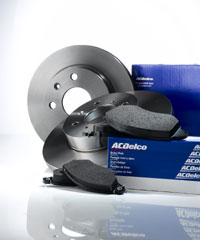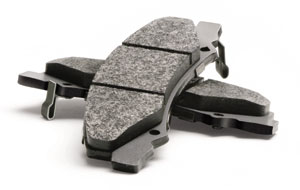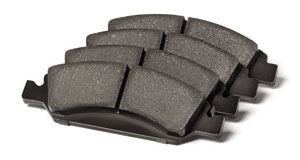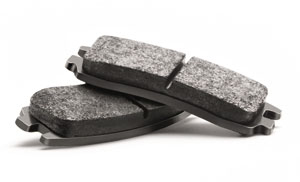
Lee Quinney, ACDelco’s General Manager, examines the differences in design and function of the various replacement brake pad types.
There’s a lot more to a car’s braking system than when a driver is simply forced to jump on the pedal. In today’s modern vehicles, there are a number of parts that serve to deliver a physical force to slow a car down or stop it. One of the most important elements of this equation is the brake pads.
Far from simple
The pressure and friction applied to the discs is what causes a vehicle to slow down or stop.
That said, although the role they play is a simple concept, brake pads themselves are anything but. Because of the speed a car’s wheels rotate at, combined with how much a typical vehicle weighs, brake pads undergo extreme stress every time they’re brought into action. They perform a thankless task and one that they repeat for thousands of miles without complaint.
Three’s the number ACDelco’s global product range offers three types of pads: Organic, Semi-metallic and Ceramic, all of which are designed to help resist corrosion and premature wear. They are equally famed for delivering quiet and low dust generating braking.
ACDelco’s global product range offers three types of pads: Organic, Semi-metallic and Ceramic, all of which are designed to help resist corrosion and premature wear. They are equally famed for delivering quiet and low dust generating braking.
Not surprisingly, ACDelco brake pads are independently tested in the aftermarket as a means of delivering the highest quality product its customers expect.
As with many car components, if not all, brake pads have themselves been subject to the process of evolution. Given their function, they definitely fit into the category of workhorse and largely remain the unsung heroes of the braking system. Getting a vehicle to go quickly isn’t a problem, it’s the slowing it down and bringing it to a stop that remains safety critical.
ACDELCO BRAKE PADS – FEATURES & BENEFITS
- The pads have been formulated to meet specific vehicle requirements to ensure a safe and consistent stopping ability.
- They provide optimum noise suppression and performance using unique formulations and are combined with shims, slots and chamfers, where needed.
- All brake pad backing plates are protected by a premium powder coated finish, ensuring professional protection and appearance.
- The brake pad’s compound is of a specially formulated Non-Asbestos Organic (NAO) material and is 100% asbestos free.
- Friction levels are very stable across a broad range of operating temperatures, and create very low levels of dust.
- Each pad is designed to provide optimum performance and durability.
WHAT’S YOUR TYPE?
Here we take a look at the different types of pads that are available and how they are equipped to take the strain.
Ceramic
 Ceramic brake pads offer the ultimate braking performance, wear well over time and are very lightweight; qualities that are important for high-performance driving.
Ceramic brake pads offer the ultimate braking performance, wear well over time and are very lightweight; qualities that are important for high-performance driving.- They are made from ceramic fibres, filler material, bonding agents and (sometimes) small amounts of copper fibres.
- Their ceramic content ensures that they dissipate heat well, which maintains performance – even after strong and repeated hard stops.
- They are less susceptible to wear and, as a result, produce less dust than alternative type pads.
Whilst sports cars that are routinely driven hard and fast benefit from ceramic brake pads, almost all other vehicles perform just as well with other brake pads; none more so than their metallic counterparts.
 Included here are not just ceramic brake pads again, but those made from carbon fibre.
Included here are not just ceramic brake pads again, but those made from carbon fibre.- One of the most important aspects of high performance brake pads is their ability to dissipate heat.
- Being made from ceramic and carbon fibre, high performance brake pads are lightweight and unmatched in terms of their durability.
- They are well liked by professional drivers, as they view braking in the same way they do accelerating. In performance cars especially, brakes aren’t just about stopping, they also aid the car’s handling through turns.
Metallic
 Metallic brake pads are the most common type used on today’s modern vehicles. However the pads are not slabs of metal.
Metallic brake pads are the most common type used on today’s modern vehicles. However the pads are not slabs of metal.- Typically, they are made from iron, copper, steel and graphite, all mixed together and bonded to form the pad material.
- The reason that these pads are so common is simple – they are cost-effective, durable and provide good performance, being adept at transferring heat generated by friction with the brake discs.
- The downside of metallic brake pads is that they tend to be heavy, which can impact negatively on a car’s fuel economy.
FAST FACT!
Being made of metal, there isn’t much ‘give’, which can cause wear on the brake discs. Also, metallic brake pads work best when they’re warm. When a vehicle with metallic brake pads first gets going on a very cold day, stops may take slightly longer than usual until they heat up.
Organic
 Brake pads were initially manufactured using mainly asbestos, due to its ability to absorb and dissipate heat. The problem came, however, when the asbestos broke down – the dangers of the dust being well documented.
Brake pads were initially manufactured using mainly asbestos, due to its ability to absorb and dissipate heat. The problem came, however, when the asbestos broke down – the dangers of the dust being well documented.- Today this type of brake pad is made from safer organic materials. Categorised as non-asbestos organic brake pads, here natural materials like glass and rubber are used in conjunction with resins that can withstand intense heat.
- Another important component in many organic pads is Kelvar. In addition they are environmentally friendly, given that they do not pollute.
- Being softer than brake pads made from other materials, they are often quieter. Such a quality has its downsides, as not only do they typically wear faster, they create high levels of dust in the process.









